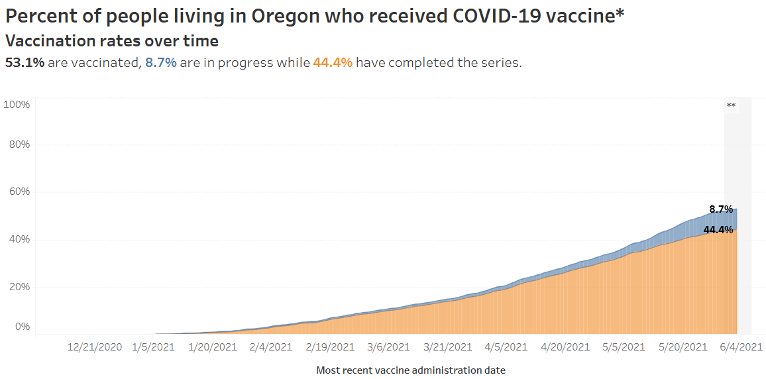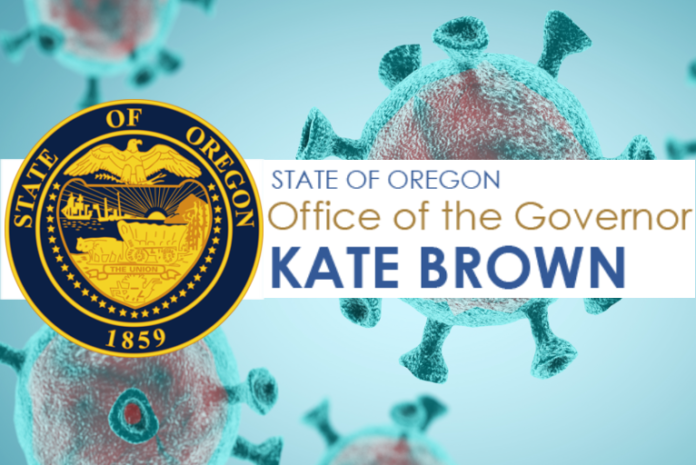Governor Kate Brown today announced the steps the state will take to lift COVID-19 health and safety restrictions and fully reopen the economy after 70% of all Oregonians 18 and older have received a first dose of a COVID-19 vaccine.
Because vaccines are very effective at protecting against COVID-19, after reaching the 70% threshold, Oregon will lift most state restrictions and move away from a state-led emergency COVID-19 response effort, shifting focus to pandemic recovery and supporting local public health and health care providers with resources.
As of June 3rd, Oregon had achieved a 66.2% vaccination rate for individuals 18 and older, with 127,308 more people needing to receive a first dose to reach 70%.

“I want to be very clear that we are able to reopen like this because of the efficacy of the vaccines. For those of you who are vaccinated, you’ve helped us reach this point — and you are protected from this virus,” said Governor Brown. “However, there are still Oregonians who need to take extra precautions to feel and stay safe. People battling cancer and immunocompromised Oregonians, to name a couple. There are also many Oregon kids who are not yet eligible for a vaccine.
“So, it will remain incredibly important for Oregonians to continue making smart choices. And, to respect the choices of others. Let’s respect one another as we prepare to make this transition.
“This has really become a tale of two pandemics. If you are vaccinated, then you’re safe, you can carry on safely without wearing a mask and social distancing.
“If you are not vaccinated, this virus still poses a very real threat.”
After reaching the 70% threshold, Oregon’s Risk Level framework, including all county-based metrics and health and safety restrictions, will be lifted. This includes mask, physical distancing, and capacity limit requirements. The state will not require masks and face coverings in almost all settings, with some exceptions following federal guidance, including airports, public transit, and health care settings.
Recently revised workplace standards, including indoor mask requirements for unvaccinated employees, remain in place for schools and child care settings.
Because the same mask and social distancing rules will apply for all individuals–vaccinated or unvaccinated–vaccine verification will not be necessary. It will still be strongly recommended that unvaccinated individuals and other vulnerable individuals continue to wear masks and practice other health and safety measures to stay safe from COVID-19.
In California, Governor Newsom and a state safety board upset business groups after approving new rules that require all workers to wear masks unless everyone around them is vaccinated against the coronavirus.
Cal/OSHA’s regulations apply to almost every workplace in the state, including workers in offices, factories and retail operations and its pandemic rules apply to all employees. The revisions are expected to take effect in mid-June.
Recognizing that COVID-19 will still be present in our communities and that many Oregonians remain unvaccinated, the Oregon Health Authority will have an ongoing leadership role devoting statewide resources local public health partners in pandemic response and recovery.
Children younger than 12 are still not eligible to be vaccinated. Some specific health and safety measures will remain in place for schools and child care and Because many children are still not eligible for vaccination remaining vulnerable to COVID-19, local schools will be guided by health and safety guidance as students resume a normal school year in the fall. Students will attend school full-time, five days per week. K-12 guidance is being revised to support schools in safely delivering in-person instruction throughout the school day.
For the same reasons, some health and safety standards for child care providers and youth programs will remain in place.
Recently revised workplace standards, including indoor mask requirements for unvaccinated employees, remain in place for schools and child care settings. For colleges and universities, where students are eligible for vaccination, individual institutions will make decisions about health and safety protocols for the coming year, after considering forthcoming CDC guidance.


















